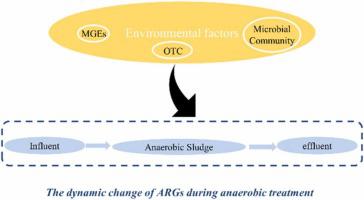Journal of Hazardous Materials ( IF 12.2 ) Pub Date : 2021-09-25 , DOI: 10.1016/j.jhazmat.2021.127352 Hong-Ying Chen 1 , Xiang-Kun Li 2 , Lingwei Meng 3 , Gaige Liu 2 , Xiaochen Ma 1 , Chenyu Piao 1 , Ke Wang 1

|
In this study, two parallel-operated expanded granular sludge bed (EGSB) reactors, one used to treat oxytetracycline (OTC) manufacturing wastewater with gradual increase of OTC concentration as experimental reactor and the other fed with the same wastewater without OTC as control reactor, were operated to investigate the behavior of antibiotics resistance genes (ARGs) and mobile genetic elements (MGEs) and their possible relationships with bacterial community among influent, sludge and effluent environments. Though the average absolute abundance of ARGs slightly decreased (0.26 - log), the ARGs’ relative abundance normalized to 16S-rRNA gene copy numbers showed a significant upward trend in effluent (2 multiples - increase) and the absolute and relative abundances both extremely increased in anaerobic sludge, indicating that anaerobic treatment process cannot reduce ARGs efficiently, inversely can increase the risk of ARGs through the proliferation of antibiotics resistance bacteria (ARB) under the suppression of OTC. MGEs, bacterial communities and OTC concentration mainly impacted the ARGs profiles, which contributed 88.4% to the variation of ARGs. The differences and correlations of hosts in influent, effluent and sludge were further confirmed by network analysis. Overall, this study enhanced the understanding of the prevalence and transfer of ARGs in OTC production effluents during anaerobic treatment.
中文翻译:

土霉素生产废水厌氧反应器中抗生素抗性基因和微生物群落的命运和行为机制
在这项研究中,两个平行运行的膨胀颗粒污泥床(EGSB)反应器,一个用于处理土霉素(OTC)制造废水,OTC浓度逐渐增加作为实验反应器,另一个用相同的废水作为对照反应器,没有OTC,用于研究抗生素抗性基因(ARGs)和移动遗传元件(MGEs)的行为及其与进水、污泥和出水环境中细菌群落的可能关系。虽然 ARGs 的平均绝对丰度略有下降(0.26 - log),但 ARGs 的相对丰度归一化为 16S-rRNA 基因拷贝数,在流出物中显示出显着的上升趋势(2 倍 - 增加),绝对和相对丰度都大大增加在厌氧污泥中,表明厌氧处理过程不能有效降低ARGs,相反会在OTC抑制下通过抗生素耐药菌(ARB)的增殖增加ARGs的风险。MGEs、细菌群落和OTC浓度主要影响ARGs谱,对ARGs变化贡献了88.4%。通过网络分析进一步证实了进水、出水和污泥中宿主的差异和相关性。总体而言,这项研究加深了对厌氧处理过程中 OTC 生产废水中 ARGs 的流行和转移的理解。细菌群落和OTC浓度主要影响ARGs谱,对ARGs变异的贡献率为88.4%。通过网络分析进一步证实了进水、出水和污泥中宿主的差异和相关性。总体而言,这项研究加深了对厌氧处理过程中 OTC 生产废水中 ARGs 的流行和转移的理解。细菌群落和OTC浓度主要影响ARGs谱,对ARGs变异的贡献率为88.4%。通过网络分析进一步证实了进水、出水和污泥中宿主的差异和相关性。总体而言,这项研究加深了对厌氧处理过程中 OTC 生产废水中 ARGs 的流行和转移的理解。











































 京公网安备 11010802027423号
京公网安备 11010802027423号